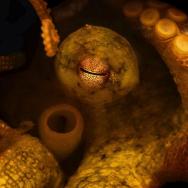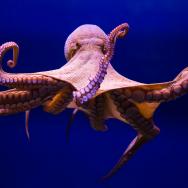The monstrous giant squid, which can grow to the size of a school bus with eyes as big as dinner plates, is rarely sighted and has never been caught and kept alive—meaning its biology (even how they reproduce) is still largely a mystery. But science just took a huge step forward with the publication of the squid’s full genome sequence.
The landmark study was led by a University of Copenhagen-led team that includes scientist Caroline Albertin of the Marine Biological Laboratory, who began the work as a University of Chicago PhD student.
“A genome is a first step for answering a lot of questions about the biology of these very weird animals,” said Albertin, PhD’15, such as how they acquired the largest brain among the invertebrates, their sophisticated behaviors and agility, and their incredible skill at instantaneous camouflage.
The team discovered that the genome of the giant squid (Architeuthis dux) is big: with an estimated 2.7 billion DNA base pairs, it’s about 90 percent the size of the human genome.
“In terms of their genes, we found the giant squid look a lot like other animals. This means we can study these truly bizarre animals to learn more about ourselves,” said Albertin, who in 2015 led a team that sequenced the first genome of a cephalopod (the group that includes squid, octopus, cuttlefish and nautilus).
Albertin analyzed several ancient, well-known gene families in the giant squid, drawing comparisons with the four other cephalopod species that have been sequenced and with the human genome.
She found that important developmental genes in almost all animals (Hox and Wnt) were present in single copies only in the giant squid genome. That means this gigantic, invertebrate creature—long a source of sea-monster lore—did not get so big through whole-genome duplication, a strategy that evolution took long ago to increase the size of vertebrates.
So knowing how this squid species got so giant awaits further probing of its genome.
“While cephalopods have many complex and elaborate features, they are thought to have evolved independently of the vertebrates. By comparing their genomes we can ask: ‘Are cephalopods and vertebrates built the same way or are they built differently?’” Albertin said.
Albertin also identified more than 100 genes in the protocadherin family—typically not found in abundance in invertebrates—in the giant squid genome.
“Protocadherins are thought to be important in wiring up a complicated brain correctly,” she says. “They were thought they were a vertebrate innovation, so we were really surprised when we found more than 100 of them in the octopus genome (in 2015). That seemed like a smoking gun to how you make a complicated brain. And we have found a similar expansion of protocadherins in the giant squid, as well.”
Lastly, she analyzed a gene family that (so far) is unique to cephalopods, called reflectins. “Reflectins encode a protein that is involved in making iridescence. Color is an important part of camouflage, so we are trying to understand what this gene family is doing and how it works,” Albertin said.
“Having this giant squid genome is an important node in helping us understand what makes a cephalopod a cephalopod. And it also can help us understand how new and novel genes arise in evolution and development.”
The team was led by Rute da Fonseca at University of Copenhagen.
The Marine Biological Laboratory is dedicated to scientific discovery—exploring fundamental biology, understanding marine biodiversity and the environment, and informing the human condition through research and education. Founded in Woods Hole, Massachusetts in 1888, the MBL is a private, nonprofit institution and an affiliate of the University of Chicago.
Citation: Rute R. da Fonseca, et al (2020) A draft genome sequence of the elusive giant squid, Architeuthis dux. GigaScience, DOI: 10.1093/gigascience/giz152
Funding: Villum Fonden, Portuguese Science Foundation, European Regional Development Fund, Wellcome Trust, Lundbeck Foundation, European Molecular Biological Laboratory, Novo Nordisk Foundation, David and Lucile Packard Foundation, Netherlands Organization for Scientific Research, Deutsche Forschungsgemeinshaft, VEGA, National Science Foundation.
—Adapted from a story first published on the Marine Biological Laboratory website.

